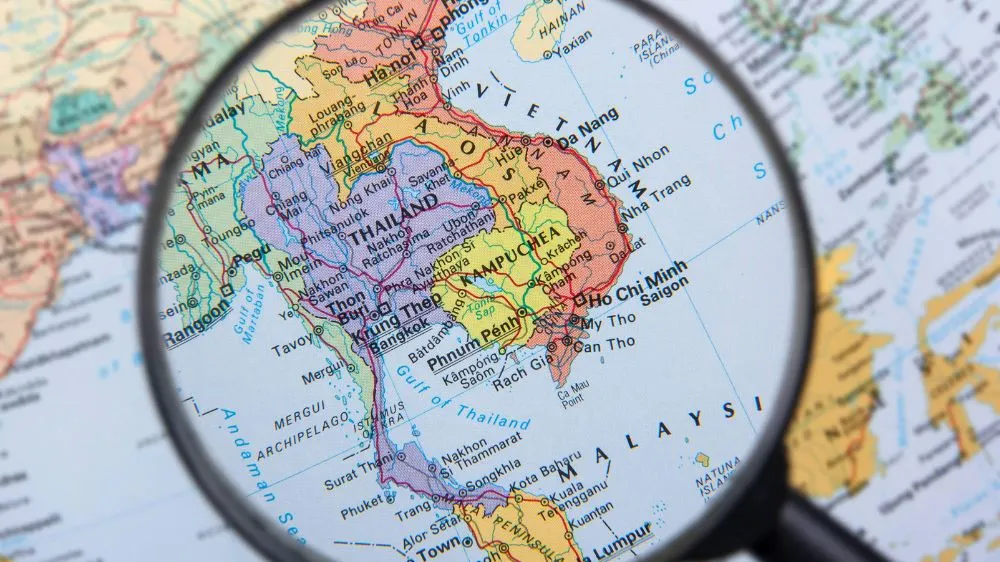Southeast Asia is no longer just a source of remote talent.
Today, global companies view the region as a strategic hub where they can simultaneously hire top talent, scale operations, and expand into local markets.
In 2022, APAC ranked as the fastest-growing region for global hiring.
The Philippines came in second in the world for number of hires,
Singapore ranked second by number of hiring companies,
and Thailand topped the list for year-over-year growth in hires.
These numbers aren’t just a trend—they’re a signal.
A signal that your talent strategy and operating model may need to be fundamentally rethought.
In Southeast Asia, it’s possible to hire highly skilled talent without setting up a local entity,
to build a distributed global team,
and to test or expand into local markets with minimal fixed overhead.
But to capitalize on these opportunities, you need to move early.
Leading tech firms and global brands have already established regional footholds—most often with Singapore as their anchor—expanding rapidly across nearby countries.
In this landscape, first movers gain lasting competitive advantages in hiring, brand presence, and operational agility.
"Expanding into Southeast Asia is no longer a question of ‘if’.
It’s a matter of ‘when’—and more importantly, ‘how’."
Why Southeast Asia?
1. A massive, growing population and rising consumer power
With over 650 million people, Southeast Asia is one of the largest unified economic zones in the world.
Countries like Indonesia, Vietnam, and the Philippines are seeing fast-growing middle and upper-income classes, expanding consumer demand and creating early-market opportunities for global brands.
2. Skilled talent at a lower cost
Across functions like engineering, design, marketing, and customer support, Southeast Asia offers a large pool of English-speaking, digitally fluent professionals.
Malaysia, the Philippines, and Vietnam in particular are home to many remote employees already working for global firms—often at compensation levels significantly lower than their Western counterparts.
3. Strategic location for regional and global expansion
Southeast Asia sits at the crossroads of Asia-Pacific, offering a launchpad into India, China, and Oceania.
Singapore, with its business-friendly environment and dense investor ecosystem, has become the go-to hub for setting up regional headquarters and expanding into neighboring markets.
4. A key lever for diversifying your global talent portfolio
As economic volatility increases, companies are seeking to reduce over-reliance on North American or European hiring.
Southeast Asia offers a deep pool of skilled, young professionals—many of whom are fluent in English and familiar with international collaboration—making it ideal for de-risking talent acquisition and building global team resiliency.
5. Entity-free hiring is structurally possible
The region offers high flexibility in employment structures, with many countries supporting remote work, freelance hiring, and EOR (Employer of Record) models.
It’s possible to build and run distributed teams without setting up a local legal entity, allowing companies to test and scale in new markets with lower upfront costs.
6. A first-mover advantage in an increasingly competitive talent market
Southeast Asia’s talent market is heating up.
Roles like software engineering, data analytics, and customer operations are already seeing high demand from global employers.
Companies that enter early gain stronger brand recognition, faster hiring cycles, and better leverage in salary negotiations.
Comparative Hiring Costs by Country (Monthly/Annual + Role Examples)
The table below compares the employer-side labor costs in key Southeast Asian countries with those of Korea and Japan—Asia’s only OECD members.
It offers a clear cost advantage perspective, along with practical examples and role relevance.
How to read this table
•
“Employer cost %” refers to mandatory contributions for social insurance, pensions, maternity leave, and related obligations.
•
However, actual employer cost depends on local salary levels, so % alone can be misleading.
•
For instance, Vietnam has one of the highest contribution rates (23.5%), but low average wages keep its total monthly employer cost under $500. Singapore, with a lower rate, ends up costing over $5,800 due to higher base salaries.
Total Cost = Average Monthly Salary × Employer Contribution Rate
Country | Avg. Monthly Salary (USD) | Employer Cost Rate (%) | Estimated Total (Monthly/Yearly) | Common Roles | Notes |
Vietnam | $400 | 23.5% | ~$494 / $5,928 | Developers, Designers | Includes pension; legal complexity |
Thailand | $450 | 5% | ~$472.5 / $5,670 | Marketing, HR | Stable cost; employer-friendly climate |
Philippines | $350 | 10.57% | ~$388 / $4,656 | Customer Support, BPO | Strong English skills, remote-friendly |
Malaysia | $700 | 1.75% | ~$712.25 / $8,547 | Backend, Data Analysts | High-skill talent; low mandatory costs |
Singapore | $5,000 | 17.25% | ~$5,862.5 / $70,350 | Strategy, PMs | High cost; regulatory transparency |
South Korea | $2,306 | ~6% | ~$2,444.36 / $29,332 | All functions (benchmark) | Strong welfare system |
Japan | $2,067 | ~6% | ~$2,191.02 / $26,292 | Planning, Ops | High costs; legal complexity |
These figures reflect estimates based on mandatory employer contributions (e.g., social security, unemployment, maternity), but actual total costs vary by employment type, seniority, and local tax law.
Lower employer costs don’t just reduce overhead—they allow you to hire faster, scale teams, and enter new markets more affordably.
Southeast Asia, with its moderate salary levels and relatively low contribution rates, offers a high-leverage environment for workforce expansion.
Still, low cost alone shouldn’t be the only deciding factor.
When planning your hiring strategy, you should also consider:
•
Language barriers (e.g., fluency in English or other working languages)
•
Time zone compatibility for global collaboration
•
Tech stack alignment (specialization by country)
•
Labor law stability (clear contracts and termination conditions)
•
Cultural fit with your existing team and work style
6 Critical Risks to Consider Before Hiring at Southeast Asia
1. Inconsistent Job Titles and Role Definitions
Case
A global SaaS company hired a "Customer Success Manager" in Singapore through a local platform. However, the actual role turned out to be front-line BPO support, not the strategic CS function they had in mind.
Problem
In Southeast Asia, the same job title can mean very different things depending on the company, industry, or local market.
Response
Rather than relying on job titles alone, hiring teams should align on specific deliverables, skills, and role outcomes when drafting job descriptions and screening candidates.
TalentSeeker maintains localized mappings between job titles and real responsibilities across countries, ensuring that your JD aligns with what candidates have actually done.
2. Unstructured or Inconsistent Resume Formats
Case
When hiring developers in Vietnam and Thailand, recruiters often receive just a couple of portfolio links or free-form bios—making it hard to compare candidates objectively.
Problem
Many candidates don’t follow standard Western resume formats, leaving gaps in timelines, achievements, and skill summaries.
Response
Hiring managers should be prepared to evaluate GitHub profiles, blogs, or project portfolios alongside CVs—and seek a platform that can normalize unstructured data.
TalentSeeker uses AI to structure and quantify messy inputs, turning unstructured resumes and portfolios into standardized data with tags for skills, experience, and project contributions.
3. Difficulty Evaluating Project Contribution and Actual Skills
Case
A candidate claimed they had led an e-commerce project—but upon deeper review, their work was limited to styling front-end components built by someone else.
Problem
Subjective or vague descriptions make it hard to assess actual contribution or technical depth. This leads to misaligned expectations and post-hire performance issues.
Response
Screening should go beyond job titles to assess project ownership, collaboration level, and output type.
TalentSeeker breaks down past projects into task-level elements and compares them with similar role profiles to visualize contribution depth and real capabilities.
4. Low Engagement via Traditional Outreach Channels
Case
A Japanese firm tried reaching a Thai candidate via LinkedIn without success. The candidate later responded to a competitor who messaged them via WhatsApp.
Problem
Preferred communication channels vary widely across countries. Some candidates ignore cold emails or formal channels altogether.
Response
Recruiters need to understand regional messaging norms and craft more personalized, culturally adapted messages.
TalentSeeker identifies preferred contact methods and generates high-response personalized messages—maximizing engagement across different communication platforms.
5. Cultural Fit and Collaboration Compatibility
Case
An Indonesian developer joined a remote team but struggled with Slack and Asana, delaying onboarding and affecting cross-border teamwork.
Problem
Even highly skilled individuals may lack experience in global collaboration environments—causing inefficiencies and communication breakdowns.
Response
Assess soft skills like autonomy, tool familiarity, and remote collaboration experience in addition to technical competence.
TalentSeeker scores candidates based on past tool usage (e.g., Slack, Jira), team structure, and cultural compatibility indicators to predict collaboration success.
6. Legal and Compliance Complexity by Country
Case
A startup hiring in Vietnam faced severance disputes due to missing clauses in the employment contract—highlighting gaps in understanding local employment law.
Problem
Labor laws, termination rules, contract language, and social security obligations differ widely across countries.
Response
Companies need localized contracts and a strong understanding of regulatory frameworks to avoid legal exposure.
TalentSeeker filters candidates by employment eligibility and helps define legally appropriate structures—while also offering EOR integration if needed.
The Rise of the Digital Nomad Workforce
Remote work is no longer a temporary trend—it’s a core part of how modern companies operate.
Southeast Asia, once seen mainly as a vacation destination, is quickly transforming into a global talent hub for remote professionals.
Countries like Indonesia, Malaysia, and Vietnam are racing to attract digital nomads by introducing remote work visas, tax incentives, and city-level infrastructure investments.
Bali, Kuala Lumpur, and Da Nang are becoming known not just for tourism, but as hotbeds for English-speaking professionals who contribute to global teams from Southeast Asia.
For companies, this opens up a new class of opportunities:
hiring highly capable, globally connected talent—without setting up an entity.
Southeast Asia now enables you to tap into global talent already embedded in the region, ready to work remotely, and easily integrated into international teams.
Platform for Southeast Asia Expansion
Southeast Asia offers enormous opportunity—but comes with complexity.
Titles mean different things, communication habits vary, and it’s not always clear who can be hired, or how.
TalentSeeker simplifies the entire process of discovering, engaging, and converting Southeast Asian talent into your workforce.
What TalentSeeker delivers:
•
Explore 300M+ global talent profiles
Search across language, region, tech stack, and task experience to precisely filter candidates based on your hiring goals.
•
Adapt to local labor laws
Instantly understand if a country requires an EOR, what employment terms are legally required, and how to structure offers that comply with local rules.
•
Reach passive candidates with confidence
Use AI-powered personalization to approach high-quality talent—even those not actively job hunting—at the right moment with the right message.
•
Seamless integration with local partners
Whether you need EOR or PEO support, TalentSeeker connects you to trusted partners to build compliant, scalable employment structures without an entity.
If you’re thinking about Southeast Asia, talent infrastructure is the place to start.
Without the right people, there is no launch, no growth, and no revenue.
TalentSeeker is the fastest, smartest way to understand, engage, and hire from Southeast Asia—so you can take that first, crucial step.








